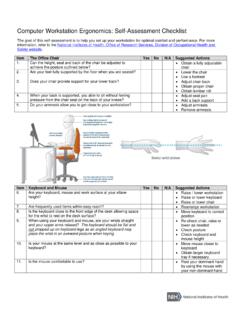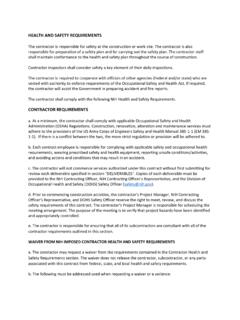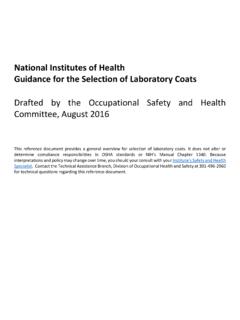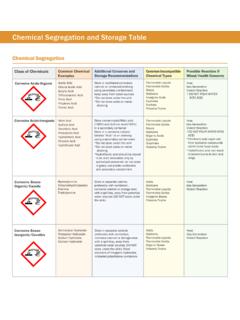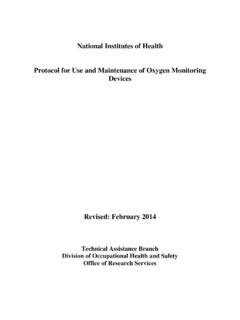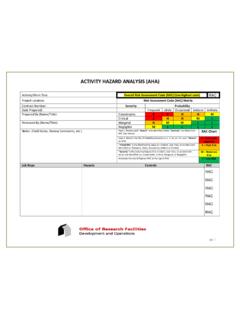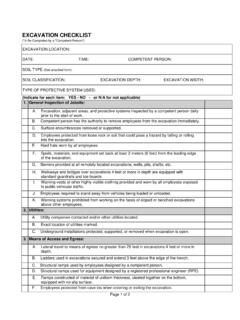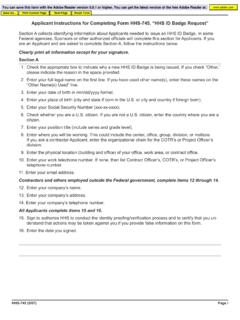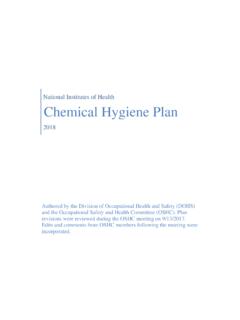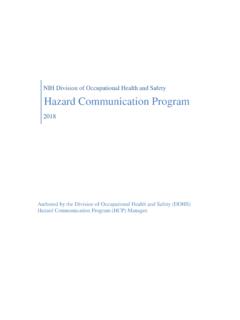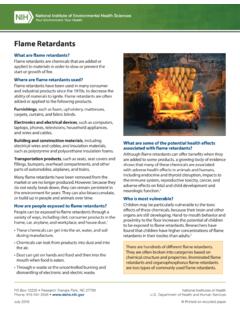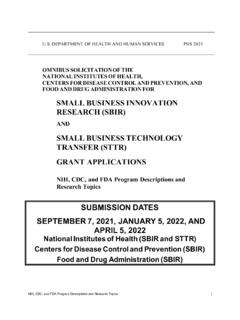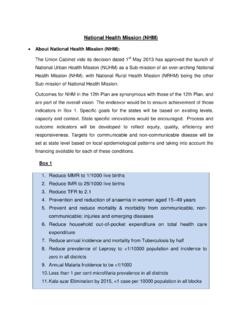Transcription of HVAC Duct Cleaning - National Institutes of Health
1 DOHS Fact Sheet on HVAC duct Cleaning National Institutes of Health Office of Research services (ORS) Division of Occupational Health and Safety (DOHS) Technical Assistance Branch (TAB) The overall indoor air quality (IAQ) benefits of routine duct Cleaning on heating, ventilating, and air conditioning (HVAC) systems continue to be reviewed and researched. Despite more than two decades of research, there is still not enough evidence to draw solid conclusions about duct cleanings benefits on IAQ, occupant Health , HVAC system performance, or energy savings, according to a 2010 review of scientific studies on duct Cleaning .
2 The review did find clear evidence that ductwork can be contaminated with dust and can act as a reservoir for microbial growth under normal operating conditions. Yet, even when duct Cleaning was extremely efficient at removing contaminants within ducts, the effectiveness of reducing indoor air pollutants was highly variable, and, in many cases, post- Cleaning levels of contaminants were higher than pre- Cleaning levels. This fact sheet provides guidance on: How to prevent duct contamination. When duct Cleaning may be appropriate.
3 How to protect building occupants during duct Cleaning . How to prevent duct contamination PREVENTION of duct contamination is KEY to avoiding problems. Follow these recommendations to avoid the need for costly duct Cleaning : Perform routine preventive maintenance on HVAC systems, by complying with manufacturer schedules for changing HVAC filters, Cleaning coils, and other components. During building renovation, seal ductwork to prevent construction dust and debris from entering the HVAC system. Maintain good housekeeping in occupied spaces.
4 Ensure that air intakes are located away from contaminant sources. Consider routine inspections of ductwork. The National Air duct Cleaning Association (NADCA) s standard, Assessment, Cleaning and Restoration of HVAC Systems- ACR 2013, recommends that HVAC systems be visually inspected for cleanliness at regular intervals, depending on building use. For healthcare facilities, the standard recommends annual inspections of air handling units and supply/return ductwork. New ductwork frequently contains oil and debris.
5 Before new ductwork is connected to the air handling system, it should be inspected for cleanliness and cleaned if necessary. Before After When duct Cleaning may be appropriate Although the value of routine duct Cleaning remains questionable, the Environmental Protection Agency (EPA) and industrial hygienists agree that duct Cleaning (or, in some cases, duct replacement) is appropriate in the following circumstances: Permanent or persistent water damage in ducts. Slime or microbial growth observed in ducts. Debris build up in ducts that restricts airflow.
6 Dust discharging from supply diffusers. Offensive odors originating in ductwork or HVAC components. National Institutes of Health Office of Research services Division of Occupational Health and Safety Technical Assistance Branch Building 13, Room 3K04 (301) 496-3457 1 05/2015 DOHS Fact Sheet on HVAC duct Cleaning National Institutes of Health Office of Research services (ORS) Division of Occupational Health and Safety (DOHS)
7 Technical Assistance Branch (TAB) How to prevent building occupants during duct Cleaning If duct Cleaning is determined to be the best option: 1. Hire a duct Cleaning contractor who is a member in good standing of the NADCA. duct Cleaning companies must meet certain requirements to become NADCA members. All NADCA members must have certified Air System Cleaning Specialists (ASCS) on staff who have taken and passed the NADCA Certification Examination. 2. PROTECT building occupants during and after duct Cleaning : Place a filter over supply and return grills to capture dust when HVAC system is placed back into service after Cleaning .
8 Perform duct Cleaning during hours when the building is unoccupied, such as nights and weekends. Use containment barriers and proper ventilation equipment, such as negative air machines equipped with high efficiency filters. Avoid the use of biocides and sealants. Even EPA registered biocides may pose Health risks, including eye, nose, and skin irritation. No biocides are currently EPA registered for use on fiberglass duct board or fiberglass lined ducts. Both the EPA and NADCA recommend replacing wet or moldy fiberglass duct material.
9 Consult with occupants with medical conditions ( immunosuppressed individuals). BEFORE hiring a duct Cleaning contractor, make sure you can answer Yes to all of these questions: Are there known or observed contaminants in the ductwork? Have you confirmed the type and quantity of contaminants based on testing or observation? Are the contaminants (or their by-products) capable of entering occupied spaces? Have you identified and controlled the source of contaminant? Will the duct Cleaning effectively remove, inactivate, or neutralize the contaminant?
10 Have you considered other options, such as removal of affected ductwork? Is duct Cleaning the only (or most effective) solution? In all cases, duct Cleaning should be undertaken only after the source of the contaminant has been identified and controlled. Otherwise, the problem will not go away. For instance, the water source causing mold growth must be identified and controlled or duct Cleaning will be only a temporary fix. National Institutes of Health Office of Research services Division of Occupational Health and Safety Technical Assistance Branch Building 13, Room 3K04 (301) 496-3457 2 05/2015 The dirty filter/vent above indicate a Cleaning is needed and should be performed by a professional DOHS Fact Sheet on HVAC duct Cleaning National Institutes of Health Office of Research services (ORS) Division of Occupational Health and Safety (DOHS)
